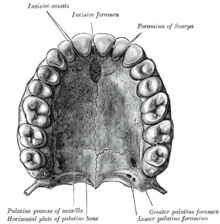Canalis incisivus
The canalis incisivus is a bony canal in the hard palate of humans that connects the nasal and oral cavity .
Its opening to the oral cavity, the foramen incisivum , lies in the fossa incisiva , a pit behind the incisors ( incisivi ; from Latin incidere , to cut into). Nerves and vessels pass through the incisive canal , on each side a nasopalatine nerve (incisive nerve) and the terminal branch of the descending palatine artery and the sphenopalatine artery . In addition, the bony canal contains ducts lined with epithelium, which in mammals represent connections of the Jacobson's organ to the nasal cavity and / or to the oral cavity in various ways or connect them to one another. In adults, these ducts are largely regressed.
In the early fetal development of the people of the forms in the posterior part of the primary palate of the incisive canal . Finally, it surrounds a pair of epithelialized ducts , the ductus incisivus , which initially represents an oro-nasal connection as ductus nasopalatinus .
Normally, this duct , which is located within the incisive canal , is closed on the palate in humans and partially recedes before birth. Its persistence is viewed as a rare malformation in the anterior maxilla . An open nasopalatine duct in humans was first described by Hector Louis François Leboucq in 1881 . Since then, about 40 cases have been clinically described in which there are one or two small openings on the side or behind the incisive papilla through which air can be drawn from the nasal region into the mouth; no intervention is necessary without complaints.
Passing structures
The terminal branch of the descending palatine artery and the sphenopalatine artery and the nasopalatine nerve pass through the incisive canal .
literature
- R H. Allard, K. de Vries, WA van der Kwast: Persisting bilateral nasopalatine ducts: a developmental anomaly. In: Oral Surg Oral Med Oral Pathol. 53: 24-26 (1982).
Individual evidence
- ↑ V. Suter, H. Altermatt, T. Voegelin, M. Bornstein: The nasopalatal cyst epidemiology, diagnosis and therapy. In: Switzerland. Monthly Dentist Volume 117, No. 8, 2007.
- ^ H. Leboucq: Le canal nasopalatin chez l'homme. In: Arch. Biol. Paris (1881) 2, pp. 386-397.
- ↑ Thomas von Arx, Michael M. Bornstein: The open ductus nasopalatinus. A rare malformation and diagnostic trap. In: Switzerland. Monthly Dentist Vol. 119 4/2009.

